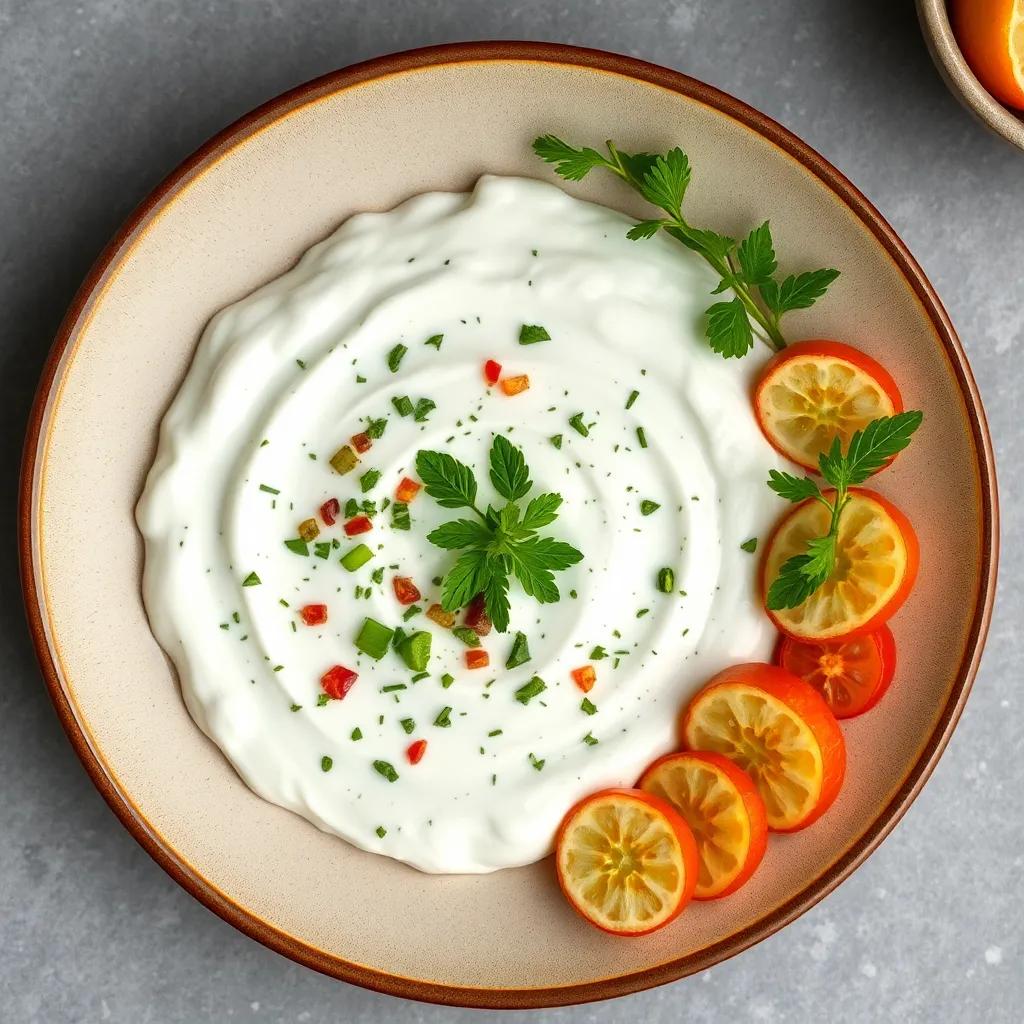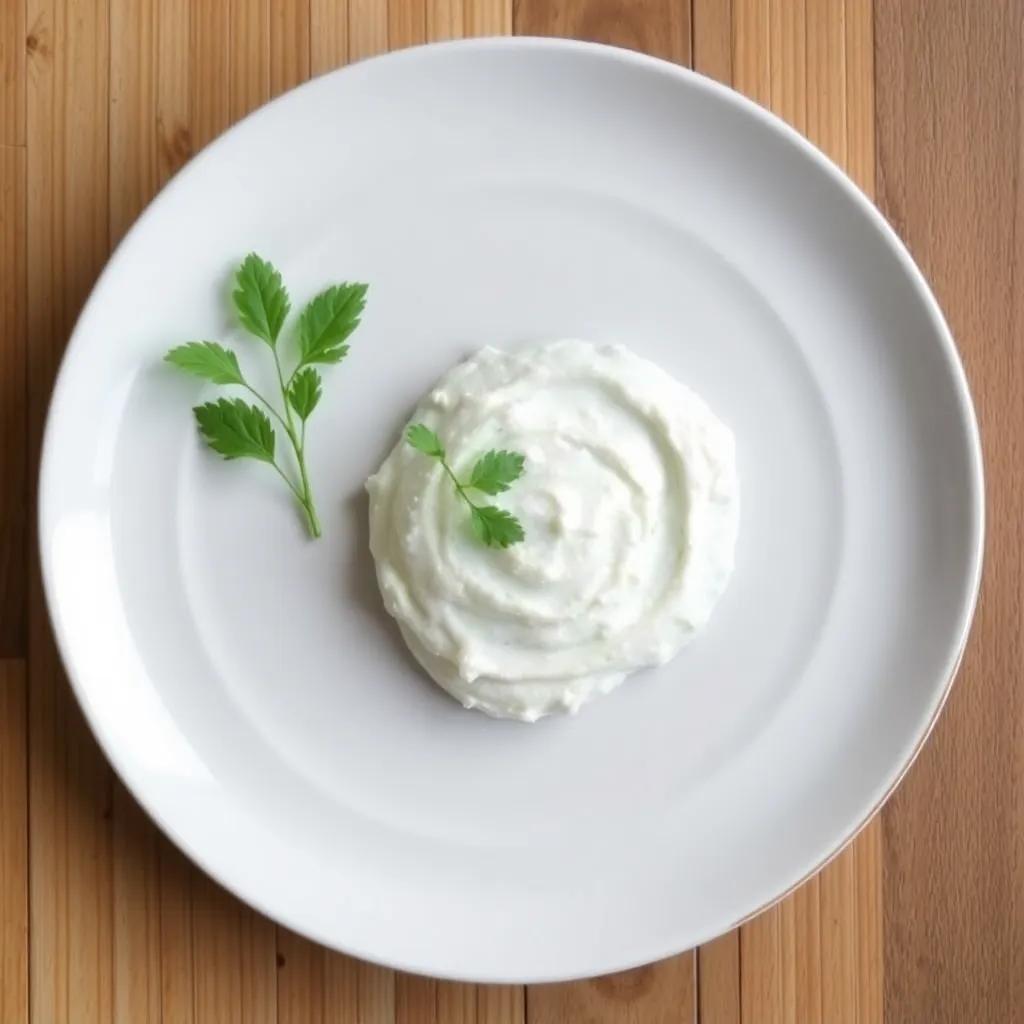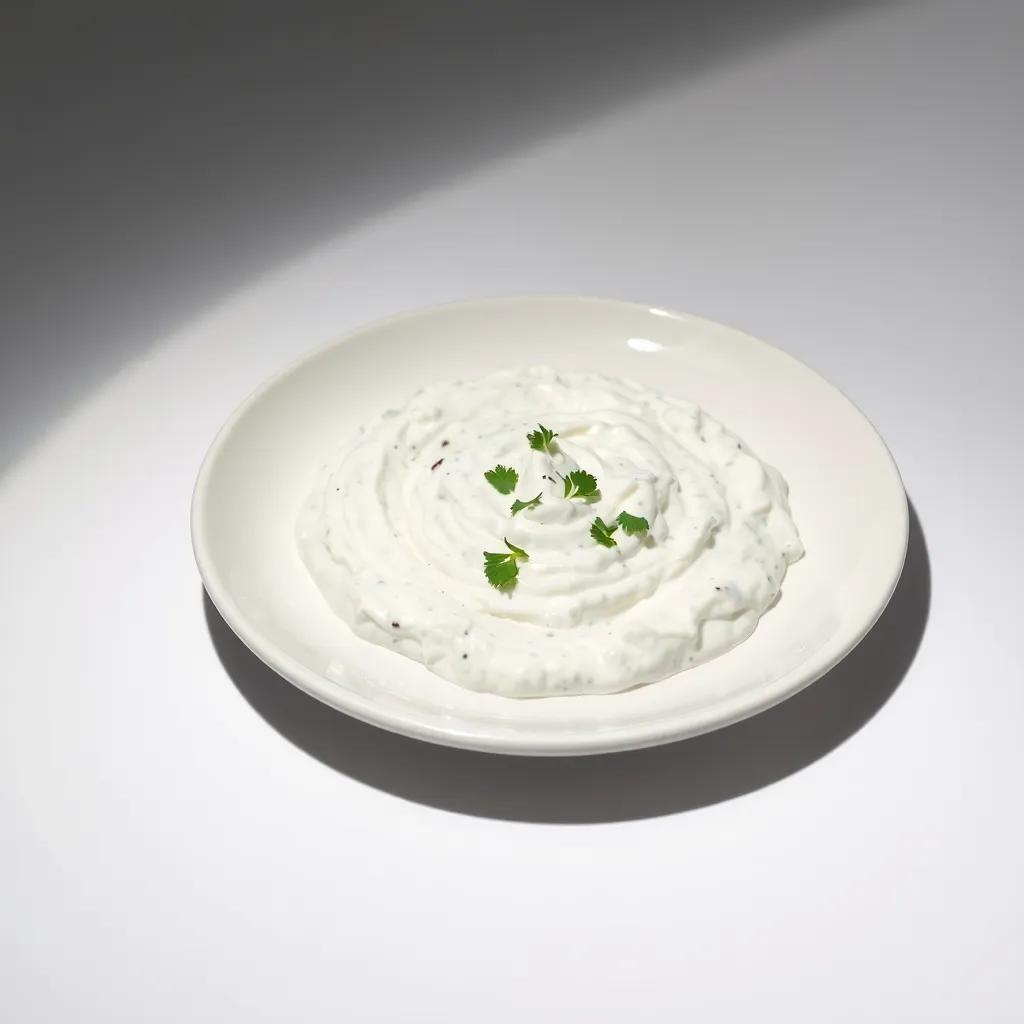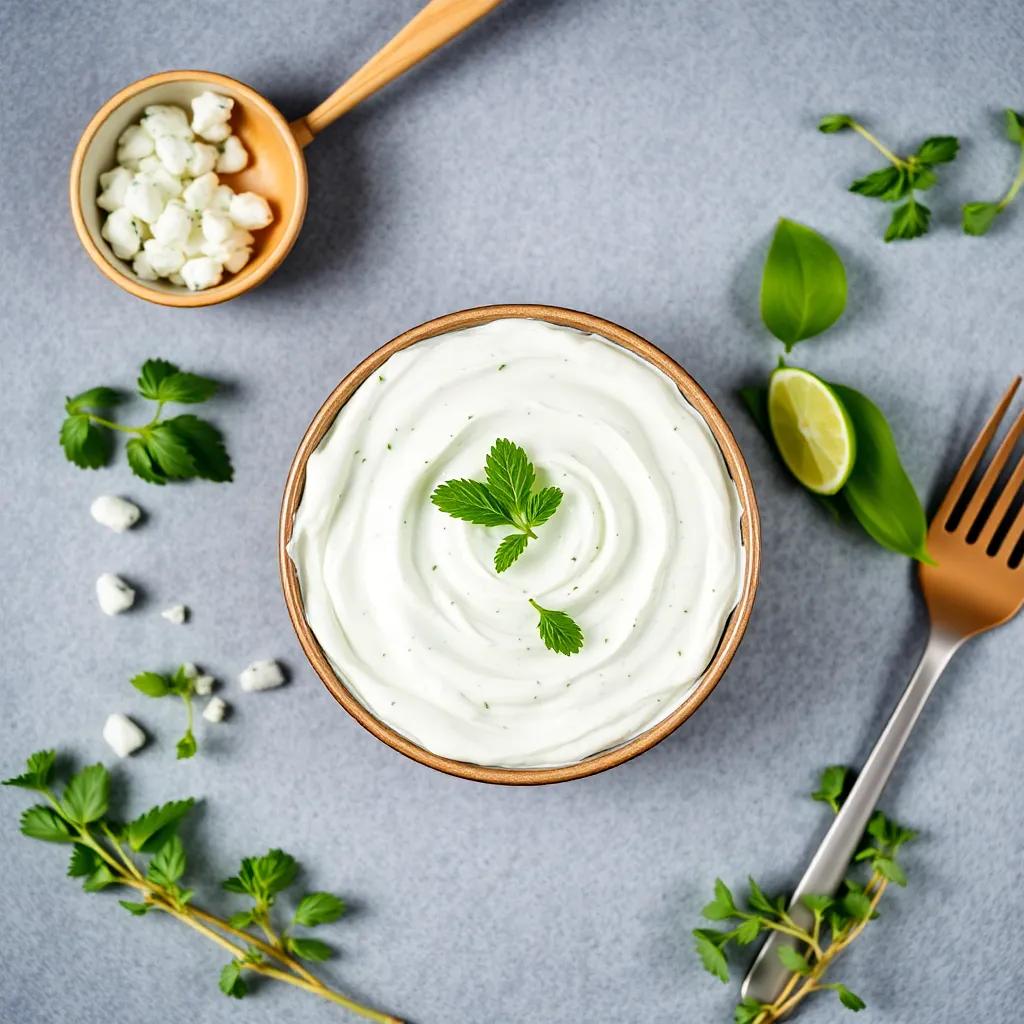Unlock Creamy Bliss: Easy 30-Minute Tzatziki Recipe You’ll Love

Unlock Creamy Bliss: Easy 30-Minute Tzatziki Recipe You’ll Love
🌍 Cuisine: Greek
⚙️ Difficulty: Easy
Ingredients
Nutrition Facts
50
Instructions
- Grate the cucumber using a box grater. Place grated cucumber in a clean kitchen towel or cheesecloth and squeeze out excess water thoroughly.
- In a medium bowl, combine the Greek yogurt and drained cucumber.
- Add minced garlic, chopped fresh dill, lemon juice, and olive oil to the yogurt-cucumber mixture. Stir gently to combine.
- Season with salt and black pepper to taste. Optionally, add vinegar for a tangier flavor.
- Mix all ingredients well until smooth and creamy.
- Cover the bowl with plastic wrap or transfer the tzatziki to an airtight container.
- Chill in the refrigerator for at least 15 minutes to allow flavors to meld.
- Before serving, stir the tzatziki again and adjust seasoning if needed.
- Serve cold as a dip, sauce, or accompaniment to your favorite dishes.
Serving Suggestions
- Serve as a refreshing dip with warm pita bread or crispy vegetable crudités.
- Use as a sauce for grilled meats like lamb, chicken, or beef kebabs.
- Top gyros or falafel wraps with a generous dollop of tzatziki for extra flavor.
- Add as a cooling complement to spicy dishes or curries.
- Mix into salads or bowl meals as a creamy dressing alternative.
- Use as a spread on sandwiches or burgers for a Mediterranean twist.
- Serve alongside roasted or grilled vegetables as a tasty dip.
Table of Contents

Intro
There’s something irresistibly comforting about a creamy, cool dip that feels both fresh and indulgent—and that’s exactly what this tzatziki recipe delivers. Perfectly balancing bright, zesty notes with a lush, velvety texture, it’s a staple that effortlessly elevates everything from casual weeknight snacks to festive Mediterranean spreads. What makes this version special is how approachable it is: no complicated steps or hard-to-find ingredients, just straightforward mixing that yields a vibrant, authentic taste in half an hour or less.
Whether you’re hosting a backyard barbecue, assembling a colorful mezze platter, or simply craving a refreshing sauce to brighten up grilled meats or roasted veggies, this tzatziki fits the bill. Its versatility means it works brilliantly as a cooling sidekick to spicy dishes or as a satisfying dip for crunchy pita chips or fresh-cut veggies. Plus, it’s an excellent choice for anyone looking to add a healthy, protein-packed option to their table without hours in the kitchen.
In short, this recipe invites you to unlock creamy bliss with minimal fuss—making it an ideal pick when you want something both fuss-free and full of flavor. Prepare to fall in love with a classic that feels fresh, simple, and absolutely delightful every single time.
Ingredient Notes
One of the stars of this tzatziki recipe is undoubtedly the Greek yogurt. Opting for full-fat Greek yogurt gives the dip its signature creamy richness and tang, setting it apart from thinner variants. When shopping, look for yogurt labeled “strained” or “Greek-style,” as these have been thickened by removing excess whey, which is key for that luscious texture. If you can find yogurt made from sheep’s or goat’s milk, you’ll encounter an even more traditional flavor profile, though cow’s milk versions work beautifully too. For a lighter option, low-fat yogurt can be used—just expect a slightly less indulgent creaminess.
Next up is the cucumber, which plays a pivotal role in delivering freshness and crunch without watering down your dip. The trick here is to grate the cucumber finely and then drain it thoroughly—excess moisture can make your tzatziki runny. English cucumbers, often sold wrapped in plastic, are perfect because they have fewer seeds and thinner skin, reducing bitterness and excess water content. If you only have regular cucumbers, peeling and deseeding before grating can help improve the texture and flavor.
Garlic is the punchy little ingredient that wakes up the entire dish. Fresh garlic cloves are always best—imagine freshly minced garlic’s sharp yet mellow bite versus pre-minced or powdered versions, which can taste flat or overly harsh. Adjust the amount based on your preference: some love a garlic-forward tzatziki, while others prefer just a hint to complement the other ingredients. If garlic’s too intense for your taste, roasting the cloves beforehand softens their flavor and adds a subtle sweetness.
Lastly, fresh dill adds a bright, herbaceous flair that feels quintessentially Greek. Fresh is highly recommended for that clean, grassy note, as dried dill can quickly lose its vibrancy and sometimes taste musty. If fresh dill isn’t available, fresh mint can offer a lovely alternative for a slightly different yet equally refreshing twist. Both herbs elevate the simple yogurt and cucumber base into something fragrant and memorable.
By paying attention to these key ingredients—Greek yogurt, cucumber, garlic, and fresh dill—you’ll ensure your tzatziki captures the creamy, tangy, and fresh balance that makes this dish so beloved across tables worldwide.
Tips & Variations
Unlocking the perfect bowl of tzatziki is all about balancing freshness, texture, and flavor, and a few simple tips will elevate your homemade dip from good to unforgettable. First, don’t skip the step of draining your grated cucumber thoroughly; excess moisture is the nemesis of creamy tzatziki, turning it watery rather than luscious. Using a fine mesh sieve, cheesecloth, or a clean kitchen towel to press out every drop ensures a thick, velvety consistency that clings beautifully to whatever you dip.
For a smoother blend, experiment with the yogurt texture: if your full-fat Greek yogurt feels a bit lumpy or too thick, gently whisk it before mixing or even briefly pulse your mixture in a food processor for an ultra-creamy result. However, if you prefer a rustic, chunky dip, stirring by hand maintains those delightful cucumber bits and fresh herb flecks.
Garlic intensity can vary greatly depending on its freshness and how finely it’s minced. If you want a mellower garlic flavor, consider gently roasting the garlic cloves beforehand. This adds a subtle sweetness that tempers the sharpness without losing character. Alternatively, for a sharper punch, grate the garlic on a microplane to maximize its pungency. Always taste and adjust—tzatziki is flexible, and your palate is the best guide.
Customization is where this classic recipe truly shines. To add a twist, try swapping fresh dill with fresh mint or parsley for a new herbal dimension—mint introduces a cool, bright note perfect for summer, while parsley adds earthiness and depth. Want a little heat? Finely diced fresh chili or a pinch of smoked paprika can gently awaken the dip without overpowering it.
For dietary variations, this recipe can easily be adapted without losing its essence. Vegan tzatziki lovers can replace Greek yogurt with thick, unsweetened coconut yogurt or almond-based yogurt for a plant-based creamy foundation. Just note that the flavor will shift with the base, so adjust seasonings accordingly—perhaps adding a splash of apple cider vinegar or more lemon juice to enhance tang. Gluten-free is naturally covered here, but if pairing tzatziki with bread, opt for gluten-free pita or use raw veggies as dippers.
If you’re short on fresh herbs, dried can be used sparingly—start with a teaspoon of dried dill and adjust to taste, but be mindful that dried herbs pack more concentrated flavor and can sometimes be slightly bitter. Similarly, if vinegar isn’t your favorite, swapping it for extra lemon juice or even a dash of white wine can brighten the dip without adding unwanted tang.
Finally, don’t overlook the chilling step. Letting tzatziki rest in the fridge for at least 15 minutes (or even longer) allows the flavors to marry and deepen, unlocking a creamier, more harmonious taste profile. If pressed for time, even a quick chill helps, but overnight is ideal when you want the tastes to fully bloom. Before serving, a fresh stir and a drizzle of good-quality extra virgin olive oil adds that final touch of smoothness and richness that makes each bite a creamy bliss.
Leftovers & Storage
When it comes to leftovers, tzatziki is surprisingly forgiving, but a few storage best practices will keep it fresh and flavorful so you can enjoy every last creamy bite. Because this dip is dairy-based and contains fresh cucumber, it’s essential to store it properly to maintain its bright taste and safe texture.
Transfer any remaining tzatziki into an airtight container to minimize exposure to air, which can cause spoilage and flavor loss. Glass jars or BPA-free plastic containers with tight-fitting lids work beautifully—glass is often the preferred choice because it doesn’t retain odors and is easy to clean. Avoid using containers that aren’t fully sealed to prevent your fridge from absorbing the strong garlic and dill aroma.
Store your tzatziki in the refrigerator where it will stay fresh for up to 3 to 4 days. The flavors may even deepen a bit as it sits, making leftovers a fantastic option for next-day snacking or as a quick sauce topper. Before enjoying again, give it a good stir to reincorporate any liquid separation that naturally occurs over time. If the tzatziki looks or smells off—cloudy, watery beyond the usual, or sourer than when fresh—discard it to be safe.
Freezing tzatziki isn’t generally recommended since the cucumber’s high water content tends to break down upon thawing, leading to a watery, less appetizing texture. However, if you do want to freeze it, consider removing chunks of cucumber before freezing or blend the dip more thoroughly to minimize separation. Thaw it slowly in the fridge and stir well before serving, though expect a slight change in consistency and freshness.
Tzatziki also shines as a great make-ahead condiment. You can prepare it a day or two in advance and refrigerate it to save time on busy days or for entertaining. Just keep in mind that cucumbers can continue to release moisture, so check the texture and adjust by draining excess liquid or blending before serving. If packing tzatziki for lunches or picnics, use a sturdy, leak-proof container and keep it chilled until ready to eat—its cool creaminess is a refreshing highlight when paired with sandwiches, wraps, or crisp veggies on the go.
By following these simple storage tips, your creamy tzatziki will remain a delicious, convenient companion well beyond the first serving—ready to elevate snacks and meals whenever you crave that signature Greek bliss.
Behind the Recipe
Tzatziki is much more than a simple yogurt and cucumber dip—it carries a rich heritage that evokes the sun-drenched landscapes and vibrant food culture of Greece. Traditionally served as part of a mezze spread, tzatziki has long been cherished in Mediterranean homes for its refreshing qualities and its ability to balance bold, spicy, or grilled flavors. Its roots trace back centuries, with similar yogurt-based sauces found throughout the region, reflecting a shared culinary tradition that values fresh, wholesome ingredients.
What makes this particular tzatziki recipe special is its accessibility and timeless charm. It’s inspired by the classic Greek approach—using wholesome full-fat Greek yogurt, freshly grated cucumber, and fragrant dill—but streamlined for modern kitchens. The quick 30-minute prep time honors the spirit of home cooking where simplicity meets flavor. I’ve personally found that making tzatziki is a kind of comfort ritual, especially during warm months: the act of grating cucumbers, mincing garlic, and blending ingredients releases an aromatic freshness that hints at long, lazy Mediterranean afternoons.
Across countless dinner tables—from bustling family gatherings to quiet solo meals—tzatziki serves as a symbol of sharing and hospitality. It invites conversation and connection, whether paired with grilled meats, vibrant salads, or simply scooped with warm bread. This recipe, while easy to master, carries with it the warmth of Greek tradition and the joy of bringing people together over food. In every creamy spoonful, there’s a taste of a place where food is both nourishment and celebration.
FAQ
Can I make tzatziki ahead of time? How long does it keep?
What if I don’t have Greek yogurt? Can I use something else?
Can I make tzatziki dairy-free or vegan-friendly?
How can I keep my tzatziki from getting watery?
Is it okay to freeze tzatziki if I want to save leftovers?
Can I customize the flavors in this tzatziki recipe?
What’s the best way to serve tzatziki?
Enjoy Your Meal!
There you have it—a simple, refreshing tzatziki recipe that brings creamy bliss to your table in just 30 minutes. Whether you’re pairing it with grilled favorites, dipping fresh veggies, or spreading it on your favorite sandwich, this easy-to-make delight is sure to win over your taste buds with its cool, tangy charm.
Give it a try and let us know how it turns out! We’d love to hear your thoughts, favorite tweaks, or any creative twists you add. Don’t forget to rate the recipe and share the love with friends—because good food is best enjoyed together.












